|

News of Redwall: The Graphic Novel first broke May 2005, when writer Stuart Moore listed it as an upcoming project in an interview with Silver Bullet Comics. Since then, fans have been treated to a slow trickle of information on the project-- credits, page counts and the like--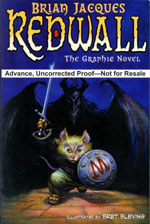 but very little that could give them an idea of what to expect, of how faithful the project would be to the original novel and how the creators approached the project. but very little that could give them an idea of what to expect, of how faithful the project would be to the original novel and how the creators approached the project.
It's time we took care of that.
I recently had the privilege of interviewing Stuart Moore, the writer responsible for adapting Redwall into graphic novel form. As a longtime comic book fan with plenty of movie and book adaptations in my collection, I was curious to learn how Mr. Moore approached the writing chores and what his thoughts on the world of Redwall Abbey were.
He was gracious enough to answer all of my questions, ranging from ones about specific scenes to pacing, story structure, Brian Jacques' involvement, the manga phenomenon's effect on the project, and the recent trend of medieval mice themed comics.
The interview was a real treat for me to do, as I'm a comic book fan whose collection already contains various issues that were written by Stuart Moore (not to mention others that were drawn by the graphic novel's illustrator, Bret Blevins). Even more exciting, the interview allowed me to get a sneak peek at the finished product, some of which I'm able to pass along to you (click on the thumbnails found throughout the interview to see larger preview pages). It should go without saying, but please do not repost these images elsewhere!
With that said, thanks once again to Mr. Moore for his time! On to the interview!
Martin (The Long Patrol): Thank you for taking the time to answer a few questions! First off, could you tell our readers a little bit about yourself?
Stuart Moore (Writer, Redwall Graphic Novel): Let's see: I started as a book 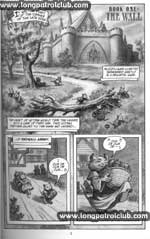 editor, then edited a lot of titles at DC Comics, where I was a founding editor of the Vertigo imprint and the Helix (science fiction) imprint. Edited the Marvel Knights line for a couple of years, then started writing full-time. Recent work includes Earthlight (Tokyopop,), Detective Comics and Firestorm (both DC Comics), The Punisher X-Mas Special and Heralds of Galactus (both Marvel), PARA (Penny-Farthing Press), and the prose novels American Meat and Reality Bites (both Games Workshop). Currently writing New Avengers/Transformers for Marvel and IDW, more Earthlight, and a lot of other things. I live in Brooklyn, New York, with my wife and two cats. editor, then edited a lot of titles at DC Comics, where I was a founding editor of the Vertigo imprint and the Helix (science fiction) imprint. Edited the Marvel Knights line for a couple of years, then started writing full-time. Recent work includes Earthlight (Tokyopop,), Detective Comics and Firestorm (both DC Comics), The Punisher X-Mas Special and Heralds of Galactus (both Marvel), PARA (Penny-Farthing Press), and the prose novels American Meat and Reality Bites (both Games Workshop). Currently writing New Avengers/Transformers for Marvel and IDW, more Earthlight, and a lot of other things. I live in Brooklyn, New York, with my wife and two cats.
Martin: How exactly did you come to be associated with Redwall: The Graphic Novel?
Stuart: I knew the packager, and he knew I had an interest in (a) fantasy and (b) bringing comics to a general audience. It seemed like a good fit all around.
Martin: Had you ever read one of Brian's books before the project?
Stuart: Like Alberto Gonzales's team, I respectfully take the fifth amendment on that question. I certainly love the books now.
Martin: How did you prepare for the job? Did you read the entire series or just 'Redwall'?
Stuart: I concentrated mostly on REDWALL, though I've dipped into the others. I didn't want to be too worried about what happens to these characters later on -- the first novel is very much a complete story, unto itself.
Martin: 'Redwall' is one of Philomel's first forays into the graphic novel market. Did the fact that the success of the project might determine whether or not the publisher sees graphic novels as a viable market add any sort of pressure to the job? Or were you relatively unconscious of that fact?
Stuart: I really didn't worry about that. I just wanted to make the book as good as it could be. Virtually every book publisher in the U.S. is dipping its toe into the graphic novel market, one way or another. If Philomel runs scared because I screw up REDWALL, I suppose I'll have to live with that shame. I'm not too worried, though.
Martin: Steve Roberts, who adapted the book for television, spoke of the difficulty involved in re-forging the "logic and objective" of book chapters into a workable form for animated episodes. Did you encounter a similar challenge, re-forging them for comic form?
Stuart: This was my first extensive adapted work -- I've since adapted some Thomas Ligotti horror stories for Fox Atomic. I discovered I took to it very easily. I think my editorial training helped a lot here; adapting a story into comics form is a strange cross between writing from scratch, and editing an existing script into shape.
Yes, some scenes that work fine in your mind's eye, when you read the book, didn't seem right when laid out in cold black and white. I had to take some license, partly because of space considerations and partly just for story flow in a different medium. My top priority in all cases was to maintain the integrity of the original story, and to use the original dialogue wherever possible.
Martin: What was it like working with Bret Blevins? How closely did you two interact?
Stuart: We've spoken a few times, but we didn't work closely. A comic-format book of this length is a strange beast; I finished the script quite a while ago, and then Bret had to draw this enormous monster I'd laid out! But he's been terrific...he loves the books and it shows in every line. The characters are scary as hell and lovable at the same time.
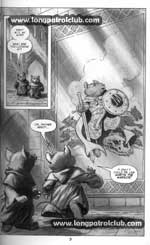 Martin: Was there any particular scene in the book that, once you'd read it, you couldn't wait to see Bret's art bring it to life? Martin: Was there any particular scene in the book that, once you'd read it, you couldn't wait to see Bret's art bring it to life?
Stuart: I'm blanking on an answer to that. I will say there were scenes where Bret surprised me. There's a quiet shot, the beginning of a scene transition, that's just a group of rat soldiers patrolling outside a church where Cluny has holed up. And it's absolutely gorgeous. The menace in those rats and the angle of the panel really takes your breath away. I'd thought of it as an ordinary, scene-intro establishing shot, and Bret made it sing.
Martin: Conversely, was there any scene in the book that you absolutely loved, but knew for space considerations you'd have to cut?
Stuart: The early sequences with Asmodeus, the snake, had to be cut a bit. I was also sorry I didn't have room to do more with Cluny's various lieutenants, or with the moles. But really, remarkably little.
Martin: One of Brian's trademarks is the division of each novel into three "books" or acts-- in the case of 'Redwall', they were "The Wall", "The Quest", and "The Warrior". Was this structure kept for the graphic novel?
Stuart: Yes, the graphic novel follows the structure of the novel very closely.
Martin: As a longtime comic fan, something I've noticed about adaptations (be they of books or movies) is how rushed they can inevitably wind up feeling. It's an unfortunate byproduct of having to cram so much story into so few pages. How did you approach this issue?
Stuart: I read through the novel once just to read it, and then a second time taking extensive notes. The page count did mean I had to cut some things, but the story is remarkably intact -- it's mostly the minor characters' subplots that had to be trimmed. And in several cases I combined scenes, partly for space and partly for the flow of the comic. For instance, the opening of the novel cuts back and forth several times between the Abbey and Cluny's troop. In the graphic novel, it worked much better to combine a few of those scenes and get on to the main action quicker.
Martin: Following along those lines, the story has three distinct phases prior to the climax-- Cluny's arrival at Redwall, the solving of the tapestry riddle, and Matthias' retrieval of the Sword of Martin from Asmodeus. Given the limited amount of pages you had to work with, which "phase" of the story had the most time devoted to it?
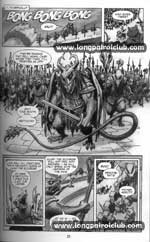 Stuart: There are a lot of mistakes you can make in adapting a long work, but probably the worst is to use up too many pages at the start and not leave yourself enough room for the emotional climaxes. I laid out the page counts very, very carefully, and wound up deviating very little from them. The middle section was probably trimmed the most, but (I
hope) it's not even very noticeable. I wanted to leave plenty of room for the battle for Redwall, which happens intermittently throughout the book; and for the Asmodeus scene, as you mentioned. And there are various turning points for Matthias that I didn't want to rush. Stuart: There are a lot of mistakes you can make in adapting a long work, but probably the worst is to use up too many pages at the start and not leave yourself enough room for the emotional climaxes. I laid out the page counts very, very carefully, and wound up deviating very little from them. The middle section was probably trimmed the most, but (I
hope) it's not even very noticeable. I wanted to leave plenty of room for the battle for Redwall, which happens intermittently throughout the book; and for the Asmodeus scene, as you mentioned. And there are various turning points for Matthias that I didn't want to rush.
I did have to trim the tapestry riddle a bit. The wordplay in the novel is wonderful, but the solving of it would have just eaten up page after page after page in comics form. The sequence is still there -- it just goes by a little faster.
Martin: Were there any characters, as you went along, that you found yourself connecting with? If so, what drew you to them?
Stuart: Well, Matthias, of course. I was sorry Shadow died so early; he was a good villain, I thought. And I like the sparras.
Martin: Let's talk about Brian. You've said in the past that he's approving every stage of the project. How did that work? Was he sent drafts of the script to review and comment on? Did you have any direct contact with him?
Stuart: No, I haven't worked with him directly. My understanding is that he's been in the loop at every stage. It's been a very, very smooth process; we planned this whole thing very carefully -- at one point, I suggested we send the scene-by-scene outline to Brian so there'd be no surprises later. I think it all worked out well, though of course you'd have to ask him.
Martin: Were there any parts along the way that Brian asked you to change your initial take on, and if so, what were they?
Stuart: I'm not sure whether it was Brian or his editors, but in an early outline I'd trimmed the story of Chickenhound and Sela too much. They asked me to put it back in because of its importance to future volumes.
Martin: The Redwall Television Series delved into some previously uncharted ground with its first episode by showing Matthias' life prior to coming to Redwall Abbey. While you obviously had less space to work with, are there any parts of the Graphic Novel that weren't found in the original novel?
Stuart: Only the occasional bit of dialogue here and there. We really tried
to be as faithful as possible.
Martin: One of the recent trends many comic news sites have picked up on is the rise of comics starring medieval mice-- David Peterson's wonderful 'Mouse Guard' and Mike Oeming & Bryan Glass' upcoming 'Mice Templar' being the chief examples. But, 'Redwall' is also frequently mentioned. The creators for both series have commented on the initial anxiety of learning of the other's project, and Glass specifically mentioned (in a Newsarama interview) buying the early 'Redwall' books after running into countless comparisons. What is your reaction to this trend and what went through your mind when you first learned of 'Mouse Guard' and 'Mice Templar'?
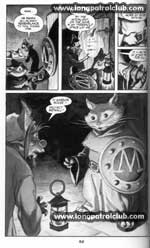 Stuart: I haven't actually read either book. But I don't see a problem here. There are thousands of high fantasy books about humans; I think there's room for three about mice. Stuart: I haven't actually read either book. But I don't see a problem here. There are thousands of high fantasy books about humans; I think there's room for three about mice.
Martin: Do you think the trend is something that has some legs and will continue to flourish or have you three-- Guard, Templar, and Redwall-- somewhat cornered the market?
Stuart: I have no idea. Obviously REDWALL has its own following already, which is nice.
Martin: Speaking of trends, a major one right now is the success of Japanese manga and its ability to tap into an audience that regular comics can't seem to grab in this day and age. The Philomel graphic initiative that 'Redwall' is a part of is, in many ways, a response to the manga-craze and an attempt to draw in that exact market. That said, what are your views on the manga phenomenon, first of all, and how well do you think 'Redwall' will be able to actually tap into that market?
Stuart: Err...this is mostly a question about bookstore categorizing and the buying habits of the big chains. Large bookstores have greatly increased their comics sections in recent years, largely because of the success of manga. If that gives us a little more shelf space to fit REDWALL in, that's obviously good. Beyond that, we're dealing with a rapidly evolving and changing market. It's a somewhat heretical belief, but I tend to think books stand and fall on their individual quality much more than where they fit on the shelves.
Martin: Do you think 'Redwall' will prove to be a good 'gateway' book, leading readers to discover more comics in general (of the "classic", non-manga variety)?
Stuart: Honestly, I'm not sure about that. The comics industry is exploding in so many directions right now: manga, art-comics, superheroes, and the sort of genre storytelling that REDWALL embodies. I do think people are coming to comics through more avenues than ever before (in the US, I mean), and probably later in life. We used to have an axiom that if you didn't read comics as a kid, you'd never get into them, but I don't think that's even remotely true anymore.
I like to think of REDWALL as its own unique piece of the comics industry mosaic. It's also very kid-friendly, which is nice. My recent PUNISHER X-MAS SPECIAL was not.
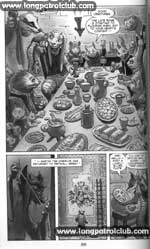 Martin: With an eye towards the future, if 'Redwall: The Graphic Novel' proves to be a resounding success (and rest assured, we'll do everything we can to make that happen!), would you be interested in coming back to adapt a sequel? Martin: With an eye towards the future, if 'Redwall: The Graphic Novel' proves to be a resounding success (and rest assured, we'll do everything we can to make that happen!), would you be interested in coming back to adapt a sequel?
Stuart: In a minute (and thanks). Especially if Bret's drawing it.
Martin: Do you have any projects in the works that you'd like Redwall fans to be sure to check out?
Stuart: I've just had two issues of DETECTIVE COMICS out (#829 and 830) -- a two-part Batman/Robin story about the siege of Wayne Tower. Upcoming:
NEW AVENGERS/TRANSFORMERS: Four issues from Marvel (and IDW) starting in July. Superheroes vs. giant robots -- I'm having a lot of fun with it. Art by Tyler Kirkham (PHOENIX WARSONG).
EARTHLIGHT volume 2: Continuing the manga-format science-fiction series by me and Chris Schons, about adults and high school students on the first moon colony, beset by terrorism, adolescence, and deadly politics. I'm really proud of this one -- first volume is out now. Vol. 2 also hits in July.
POSTCARDS: A very cool anthology edited by Jason Rodriguez, from Random House in June. All the stories are written around actual, old postcards found in junk shops -- some of them were pretty strange. I've got a story with Michael Gaydos (ALIAS) about the travelling tic tac toe hustlers of the early 20th century.
There's more in the fall. I do a periodic email newsletter, a few times a month; if anyone wants to subscribe, just send an email to stuartcomics [at] mindspring.com . The next one will probably run down my upcoming projects in greater detail.
Martin: Any last words before we go?
Stuart: I just want to say that I appreciate the strong feelings so many people have toward REDWALL. I've done my best to craft a faithful adaptation that works whether you're a fan or a newcomer. And Bret's the one who's made it all work. This is the book he was born to draw.
Martin: Once again, thanks so much for taking the time to answer some questions. We are eagerly looking forward to the finished product!
Thanks again to Mr. Moore for taking the time to give The Long Patrol this exclusive interview! Check back soon for a follow-up interview with the illustrator, Bret Blevins!
|







